
1985 with son Adam on his first birthday still in diapers at Ala Moana.
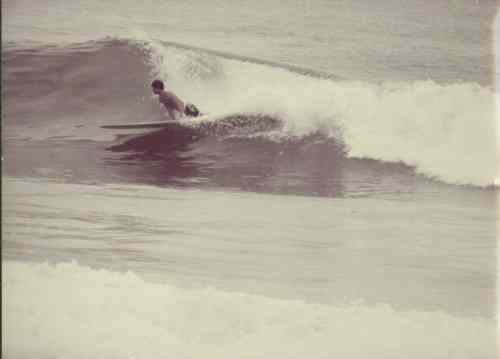
Surfing Biarritz 1965. Photo courtesy International Surfing Magazine.
Leigh-Wai contracted polio soon after birth, however, his achievements include Punahou Student Association President 1964, Attorney- Harvard Law 71 JD, Honolulu City Council member, founding Assistant Dean of Hawaii s only Law School and chair of various boards and family man. He was also a dedicated surfer who developed a unique style that allowed him to ride the waves of Oahu and elsewhere. He was accepted by his peers for his wave riding skills, that allowed him a freedom not experienced on land. Leigh-Wai was also recognized as a Legend of Big Wave Surfing by the Eddie Aikau Family Foundation along with Peter Cole and Ricky Grigg.
 1985 with son Adam on his first birthday still in diapers at Ala Moana. |
 Surfing Biarritz 1965. Photo courtesy International Surfing Magazine. |
1. What motivated you to start surfing? When was this?
Summer 1956 while waiting for the bus after summer school, a classmate friend impulsively said let's go surfing? A surprise sure? We rented the new, pink foam surfboards at Waikiki beach in front of the old Outrigger Canoe club location, then near the Royal Hawaiian hotel. The friendly beach boy asked if I could swim, of course I could and so he helped put the board in the water for me. That wonderful sunny day of 3 foot waves with outrigger canoes surfing nearby. I had the thrill of my life and caught three waves. Everyone in the water were immediately new found friends. I went back the following day and caught 13 waves and excitedly told my two older brothers and they got excited to try surfing but they were busy with their summer job picking pineapples in the plantation fields.
Through the summer of 1965, I surfed nearly every day and lost count of how many waves I caught each day. Amazingly I could go surfing alone, but not be lonely with all the camaraderie of people looking out for each other, where if someone lost their board we would retrieve it and paddle it out to him. That was standard. Catching the same wave at Canoes, Waikiki was fine and fun. No big egos. If one person caught a wave and the other didn't, that person would say to the other your turn now go for it. Waikiki was a happy place, surfing was a sport to do with newly made friends while riding alone or on the same wave. I was 12 then, and became very passionate. Surfing gave me the chance to do what I could without holding people back as Team sports do, or to be compared with others. I soon learned to do what I could do and forget what I couldn't do, which was stand up. The important thing was I could with strong arms catch waves, ride them and swim for the board if I lost it. Psychologically, I was freed from mental comparisons and I loved the ocean, saltwater and the limu (seaweed) floating. Sun, wind and the reef below with fish darting or lazy swimming. At 12 through 14, I was a small kid, discovering what I loved and being able to do it without holding anyone back as I did on the land in trying to play kickball, baseball or football. I could be myself happily independent of others in the surf. Waikiki was a perfect place to do it. It had surfboard racks to rent, just outside of the surf shop at Hale AuAu, the bathhouse where the police station is now.
2. What did your family think about you surfing?
My parents were wonderfully tolerant. Even though their friends considered surfing as selfish play, good for nothing, a waste of time instead of studying to get good grades, go to a good college and get a good job, Mom and dad did not stop me from surfing. They had spent much of their life worrying about my development with polio weak legs and social integration. My mother helped me , still 12 years old , get my first surfboard by calling upon my uncle Yankee Lee , who improvised, traced a new Hobie foam surfboard, and shaped a beautiful replica out of Styrofoam, with a redwood stringer for strength. It wasn't until we put fiberglass and resin on the shaped styrofoam, that we were all shocked that the resin melted the styrofoam into a mush. No problem. Uncle said we could cover it with cheesecloth and arabal, a rubberized paint, that added 15 pounds to the board's weight. For the rest of the summer I had the heaviest board in Waikiki and kept it in the Waikiki surfboard racks near the Hale AuAu. I was happy as a clam. Independent and surfing, my older brother Wayne took me with him when he shopped for a board and we checked out Swim Boats, Hawaii surfboards and saw Bob Shepherd and Wally Froiseth making new foam surfboards in a garage. I was 13 or 14 then. When my older brothers would go surfing, Wayne would let me tag along with his friends, five or six surfboards on top of the car to Haleiwa or Chun's Reef or Pupukea. Surfing and even the long drive to the North Shore Oahu was fun.
My father was silent when I asked him if he would pay for me to get a new commercially made foam surfboard so I didn't have to ride my nicely shaped, but extraordinarily heavy Uncle Yankee surfboard made out of Styrofoam and Arabal. Dad didn't answer me until the following day when he approved me getting a custom-made board by George Downing. It was long after that I learned that my dad's youngest brother Fookie-Fook Chow Doo, an AAU swimming and gymnastics champion, died at 18 from internal haemorrhaging after being hit by a surfboard in Waikiki in the early 1930s. Dad never told me but others did including his sisters. Fookie may have been the first person to have died from surfing, ever. Certainly one of the first and he was an American Athletic Union champion swimmer and fine surfer. Auwe no (How sad, bad, grief).
3. What board did you first start with? Where did you first learn to surf?
Those were the days before 1959 of my surfing Canoes Waikiki which included long paddles out to Populars, sometimes to the next break Paradise, and rarely to Number Threes and then back to Canoes Surf and the Hale Au Au surf rack, where I would ask someone walking down the beach to please carry my surfboard up to the racks, and bring my crutches back down so I can get out of the water. It was all a joy. It was my Elysian Fields . Carefree, untroubled, with my own surfboard, surfing Waikiki from dawn to dusk.
I was in heaven when George and wife Gildea Downing came to our family home with my new beautiful transparent blue, 9',4" surfboard with a yellow fin. I was in love and slept with her in my bed through the night. Happy. Then after, many a night, I would dream, imagine taking a drop, straight down, bouncing off the bottom and shooting up towards the upper lip to plane off into a tube or long lineup going left or right.
At 14 1/2 years old I got my drivers license and with my brother's hand me down car would do my regular South Shore surfing at Ala Moana Poles, now called Bowls and across the channel at a fabulous spot called "garbage hole" where Magic Island is now. With the car, my freedom was expanded. Not only did surfing allow me to independently get into a sport, surfing, by myself but also I could go anywhere with my car. What freedom and confidence and self worth that gave to a young teenager, finding himself, me. I could drive and surf anywhere and classmates often wish to be riding with me driving.
Importantly, also, I did not fear drowning. Those were the days without leg ropes and to ride on the edge you took risks, including falling off. Swimming came naturally, but also did the dead man float taught to me by Mrs. Harbottle, a sturdy, rotund, Hawaiian lady, who was hired by my parents to ensure that we were water safe. Period. Mrs. Harbottle taught us to be confident, calm and patient alone in the ocean with a current pulling us out to sea. Fortunately, my parents built a small swimming pool for me to exercise my polio legs, and when I was drawn to big wave surfing, I trained for big time wipeouts and swimming alone, a long time. I may be slow, but I could swim a mile or two and several hours at least.
4. Were there any role models for you or did you have to figure it out yourself?
I did not know of anyone prone surfing. Surfing movies were just coming out then in the late 1950s through early 60s and those images stay with us. But I had no imagery of anyone lying down and surfing a longboard. Even short paipo boards were uncommon. My memory is that back in the late 1950s and early 60s Paipo boards were made out of wood, like a sheet of plywood cut small about 18 inches and the rider would have it as a planing surface gripped by hands on both sides. Held in front of him, and when he has caught the wave, he might pull his head and upper chest up on top of the backside of the paipo board and slide with less friction. That was seen often at Sandy Beach shorebreak and Makapuu beach; flips and turn manoeuvres are marvellous as they go so fast; that short paipo board is in contrast to one hand wood board with a hand grip to raise the body when on a slide across the wave or in a tube. That handboard I never considered a Paipo.
The longer Paipo boards made of wood were fundamentally the length of a person s upper body; 2 feet or larger, but less than 3 feet; The writer would have most of his chest on the board and paddle with his hands, while catching the wave propelled by kicking his legs. Upon catching the wave, the rider might pull his full chest onto the board with his head ahead of the front of the board. Some of the riders would pull themselves onto the board entirely with their legs tucked under their body, and ride like he was sitting up, but with his legs tucked under him. Great to see. Paipo riding could be seen at Point Panic at the Kewalo basin, the Kapahulu groin, Sandy Beach, Makapuu Beach, Makaha Beach, Yokohama Beach, Mokuleia reef break and other places with a powerful quick takeoff over shallow reefs/water. The most famous must be the Banzai Pipeline where there have been some fantastic rides by Cunningham and others. Except for the Pipeline, I do not know of other North Shore spots, but there must be some. Of course I ve missed a lot because I didn t paipo board, couldn t with my legs. East shore Oahu must have some spots like Pounders Beach, Laie-Kahuku.
But I picked up advice from the old timers:
From Butch Van Ardsdalen, at Sunset Beach when you go over the falls and hit the bottom, push-up as hard as you can and you can pop through the bubbles with enough time to grab a swallow of air before the wave grabs you back into the washing machine. I had to push with my arms.
From Fred Van Dyke, when the current is pulling you out to sea on a big day, relax, take your time and swim diagonally if you can. When the current dissipates try to get into the surf again and ride the white water to shore. My eighth grade teacher, Mr. Van Dyke urged me to stay in school, study, get a good job and surf more in the long run. Many of his friends left school to surf but later, had to work with no time to surf. That was very important to me as a youngster in the eighth grade through law school.
From Peter Cole, who I watched swimming laps during his lunch hour in the Punahou swimming pool: Teacher Peter Cole would hold his breath doing two laps underwater, on a single breath, as preparation for his riding and wiping out at Waimea Bay.
From Ricky Grigg PhD, he showed me in the most serious of times to have fun as when at Sunset Beach on a good size wave, he was in the channel and saw me in the lineup, going into a tube and started, pretending he was the cameraman winding the film; or in a surf movie when he was about to wipe out on a wave at Waimea Bay and chose to dive into the face horizontally to body surf the wave, a big wave. We also travelled to the northwest Hawaiian islands, to Kure Atoll and Midway Island through his arrangements with the federal government. To get approval, about a dozen of us from the Honoluu City Council boarded a DC3 Coastguard airplane that had a scheduled supply stop to Kure and Midway. This was an official site inspection, confirming the NW Hawaiian islands now called Papahanaumokuakea, to be identified as part of the city and county of Honolulu. On Midway, Ricky Grigg, Ron Walker (head expert for the Hawaii Department of Land and Natural Resources) separated from the official group. Ron secured a small Boston whaler for us to go diving in virgin NW Hawaiian waters. We free dove over the reef into the drop off of the deep, deep blue and marvelled at many fish not seen in the main Hawaiian islands.
From Buzzy Trent, who most old timers would say was among the balliest guys around, when I called him and said Buzzy, this is Leigh-Wai Doo, do you remember me? "Leigh Wai, oh you got balls"! What a compliment and all for good fun.
Role models? In those early days some of those folks would be called the opposite, the less accomplished were called surf bums, good for nothing. Don't waste your time. In those days without television and Internet and surf contests. Almost all parents saw no future for surfers and shunned their happy go lucky lifestyle with no money.
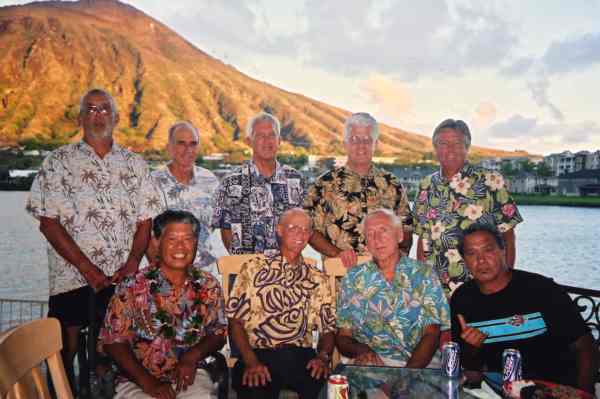 Photos by Greg Lui Kwan, courtesy of Leigh-Wai Doo. |
 Joey Cabell, Peter and Sally Cole, Carissa Moore, Fred Van Dyke and Leigh-Wai Doo at Fred van Dyke's birthday 2014 in Leigh-Wai's yard 2014. |
 Fred and Joan van Dyke are in the foregound in the group photo. Photos by Greg Lui Kwan, courtesy of Leigh-Wai Doo. |
5. A friend recalls seeing footage of you in the Surfs Up TV series from the 1960s. The footage stayed with him over the years. Do you recall the show and being featured in it?
No, I did not see the Surfs Up TV series. Aw shucks. Perhaps Hawaii was too backwards back then. I did not even know what fresh peaches looked like, or tasted like. In the early days, all food, fresh fruit and vegetables came by ship to Hawaii. Jet airplanes arrived in 1959 for passengers, with cargo shortly after. Hawaii only had three TV channels In the early 1960s and none of them carried surfing shows or even weather surfing reports, none.
We did have surf movies shown in the high school auditorium in the early 60s, perhaps two or three a year. I have heard that I was in several of them. One that stands out is "the Angry Sea" by John Severson with me, riding a good size wave on a windy day at the Sunset Beach inside reef lineup. My board at the tail end of my ride flies up into the air for about four seconds twirling before it comes back down. Other filmmakers may be Walt Phillips, Bud Browne. Basically I was a young kid 16 and 17 when riding the North Shore, while most others nearly all were older, the pioneers of North Shore surfing.
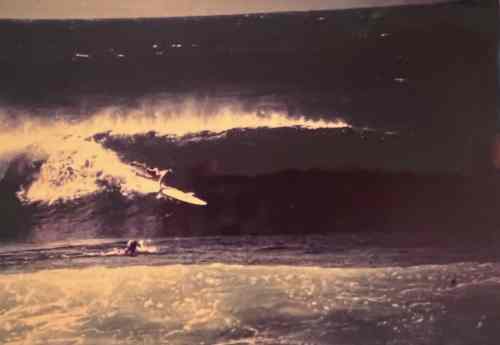 Ala Mona Bowl 1963. |
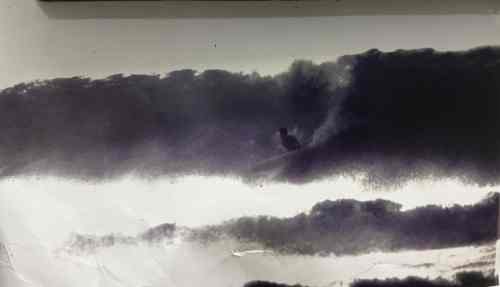 Surfing Sunset Beach aged 17. |
6. How long were the boards that you rode? Were they specially made for prone surfing or were they standard surfboards? Did your boards change much over time?
At age 14, my first commercial surfboard was from George Downing which I spoke about earlier; he and his family have remained close friends of mine, ever since then, and he has many wonderful stories to tell, including one that he wrote "the wave I didn't catch..". It was among the biggest ever at Makaha, and shared that story with me to ease my regret that I did not catch the biggest of the big waves on the night that Ala Moana Poles broke in two.
Over the years, I had many commercially made surfboards, most secondhand including a Hobie hotdogger, Hansen, Bragg gun, several Ben Aipa among many others, but one special efforts stands out . At the surf shop of Hobie, it was Mickey Munoz, who recognized me from surf movies, and remarked how quickly I could turn the surfboard. He wanted me to try out a very short board, which in 1962 was highly unusual. Today it is common, but then very rare, 5'6" maybe when normally I am riding a 9 foot board. He made a beautiful short board that I paid a greatly reduced price for but as it turned out, I did not get accustomed to riding it unfortunately.
The boards I had were stock standard nothing fancy 9 foot to 9 foot six , thick easy to paddle single fin about 21 to 22 inches wide. Most were used, that I purchased off the rack secondhand. The new ones were from George Downing, Hansen, and one Ben Aipa. Two guns: one was by Bragg which Jock Sutherland later bought from me. The other was a Downing Hawaii gun shape which I broke in half at Sunset Beach. The guns were 9'6" and 9' 10". One special effort stands out. Except for the Hobie and Munoz shortboard, all the others, were 9 foot to 9'6". I had a 8'6" Ben Aipa, custom-made surfboard with the notched wings in the back that I had shipped to me and used in New Zealand and Australia. When I left Australia, I sold it there.
 October 1967. |
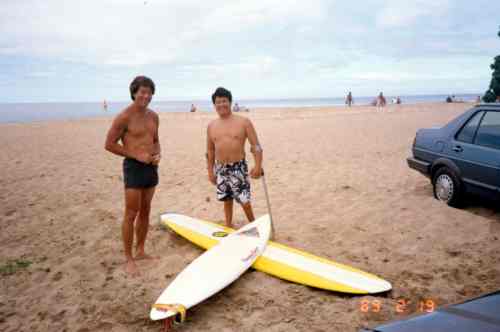 With Fred Fong - 1990s. |
|
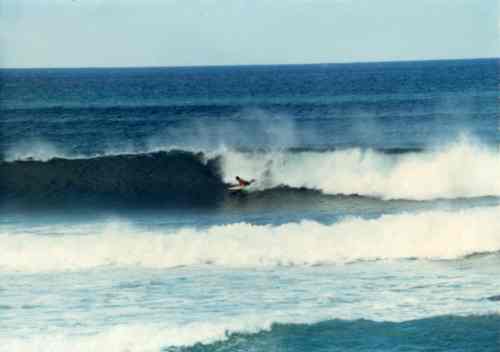 Surfing Jocko's. |
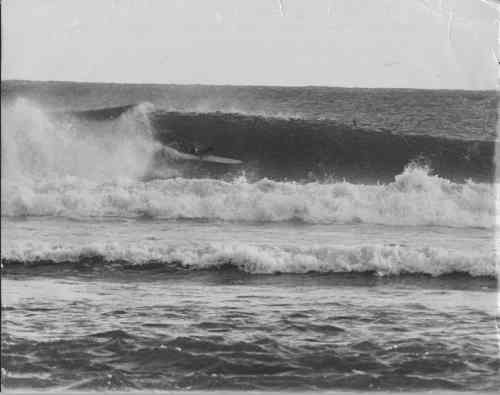 Ala Moana bowl. |
7. What technique did you use to ride waves? The 1963 Surfer magazine article refers to you riding on your hands and dropping your leg into the wave to turn?
My arms were in good shape then. My right leg was OK about 40% of normal and my left leg was about 20% of normal muscle. So when I surfed, I did what unconsciously came naturally. I could raise my body's upper parts on my arms and use my left leg as a pivot with my right leg, helping to accelerate a turn left or right by dropping it into the wave side that I wanted to go. I also had the advantage with my hands of grabbing a rail and using a bit of force to swing the board left or right. Very often on a straightaway wave when I wanted to slow down so I could get tight into a tube, I would horizontally sharply lower one rail to have the board drop to the bottom of the wave, and then I'd pull up hard on the rail to climb quickly up to the top, the crest again. And then lower the rail to get into the tube tight, that was pretty common to do back then. Upon coming out of the tube I again grabbed the rail and dropped my right leg to try to swing back into the shoulder of the wave after the tube going left and vice versa. Lots of fun. Longboard days with little hotdogging on bigger waves.
 Surfer magazine 1963, (v4, #3, page 18). Thanks to Tim De La Vega for sourcing the article. |
8. In the Surfer magazine photo, you're prone and under the lip at Ala Moana. I heard that you also rode Pipeline. If the wave shutdown you'd be in a vulnerable position prone on a longboard. This was pre-leg ropes, so you must have put in a few hours working out how to ride hollow waves?
Right, preparation in advance was for me important physically and mentally. That's the right mindset psychology of feeling confident that we're capable of handling it. I recognized the example of Peter Cole during his lunch hour of school time swimming including breath holding two laps. That was a fine example for me because my parents without telling me built a swimming pool for me to exercise my legs as a youngster. So during my junior and senior year, I would get up an hour to half hour early with Clearasil still on my face and start swimming laps in the cold water every morning. I strove to swim a mile before leaving for school.
I even cut my hair short crew cut so I didn't have to take time to wash it. All I needed was to dry it. With the confidence and training that I had on doing the deadman float, totally relaxed, head up when you need a breath and then back down. I felt comfortable. Going out I was cautious and studied the wave, the line up, where the other surfers were and who looked like he is going or not.
To me, the hardest part of surfing is the takeoff, to commit to catching the wave, to be totally enmeshed in the wave, hoping to feel for the drop or to back off and not go over the falls. If I went over the falls like in a washing machine, my main focus was to relax, conserve my oxygen and push off the bottom. I once had a shallow water black out at Sunset, but came back out of it soon, with no harm done, coughing-catching my breath with no harm done.
On the North Shore swimming long without tiring was necessary and required keeping calm, going with the flow diagonally and taking the white water surf in when the current dissipated; sometimes that took a while, a long while, but all is OK. Later I got into spearfishing, particularly on Molokai. The long relaxed swimming was great and enjoyable and allowed the fish to relax too and come closer in. I was pretty good with an arbollette and weighted belts.
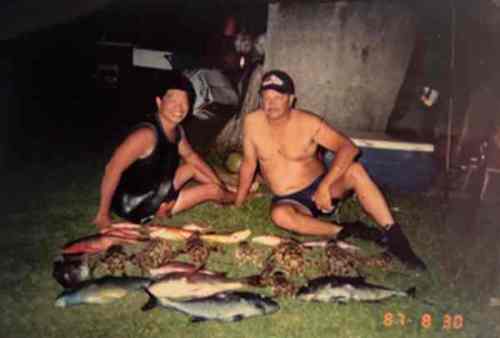 Spear fishing in the 1980s on East End Molokai. |
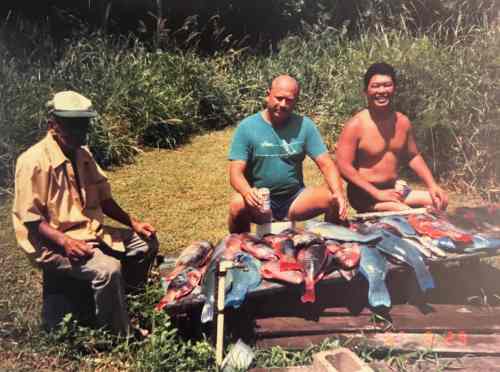 Leigh Wai Doo with Earl Almeida and Halawa resident Charlie Kalaau. |
I heard that you used to play a harmonica in the surf?
A little bit. While waiting for the set waves. Often there would be a long pause, waiting. I would try either of two things. One, dive off the board and check the reef under the board or two, pull out a plastic harmonica. I used to play old time folk music, things like Home Sweet Home.
I also heard that you had your crutches taken by the marines while surfing Trestles
I would leave the crutches in the sand while surfing Trestles. I don't know who took my crutches. No one was supposed to surf at Trestles but we did. We used too walk in or paddle down from San Clemente and walk the shoreline before paddling out.
9. Looking back, do any surfs stand out? Where did you like surfing most?
I am an old man now, 77 years old, and these memories are important and fresh.
One. The night that the Ala Moana poles- steel channel markers, - broke in two because of the huge size of the waves. Being the last two people out, Peter Cole and myself surfing Ala Moana poles with surf breaking in the channel and then that night breaking the poles entirely in half. The channel there was 17 1/2 feet deep, so the breaking wave must've been that size? Scary but thrilling. No leg ropes. We rode a few waves and then went in as it became dark. The Ala Moana steel poles were not replaced, rather as channel markers they anchored large buoys further out into the ocean channel. Makai (seaward, to the sea).
Two. Guethary surf spot, France
Spring 1966, heading to Biarritz from Spain. I'm on the bus, a little tipsy from Tinto the wine and I look out the window and I see wonderful peaks shifting like Sunset Beach. I leave the bus and asked to borrow a surfboard from a few surfers on shore. I have no wetsuit and it is cold. Two others are in the water with wetsuits. I ride two waves fine, on the third wave I wipe out and have to swim to shore. The cold water made my head feel like my skull was gonna crush my brain. Tighter and tighter, more and more pain. Finally, I get to shore and warmed myself around the French surfer's fire. Thank goodness.
Three. Waimea Bay, my one and only time. Steve Bigler, my age calls me and said let's surf Waimea, conditions are perfect, no wind and Waimea is breaking. It's still very early and we skipped school. One other person is out Max Lim, a respected old time big wave surfer. No one else. We get through the 8 foot shore break by timing our dash to get out beyond the break. I loved being there - huge waves thick, passing under us with hardly anyone out, so no worries about others taking off. The worry was paddling for the wave, the big big wave and getting pulled backwards and upwards, even though I was paddling forward. Paddling hard, anxiously. Waiting for your board to feel the motion of moving forward. Worrying about being too late and caught going over the falls. No matter, the moment of truth, be committed go for it - don't hesitate, paddle as hard as we can push. Push, get towards the nose cause the board to drop.
Then all of a sudden out of nowhere, you're freefalling, your body is separated from the board and without thinking you try to land without tipping over and keep a slide going while this huge wave, maybe 15 plus feet, has tons of white water coming behind and around me. I try hard to get in front of the rushing foam before it catches, swallows me. Trying to buck and toss me off my board. Whew you made it to the shoulder. Breathe a great sigh of happiness. Safe.
By the second wave, the wind had started to pick up, the waves were a little bigger, too, and the wind would blow up the face of the wave. That blowing up the face, accelerates the higher up, the wave gets. So by the time you kind of make the board drop down, the wave is pushing the nose of your board up not allowing your board to slide down. I've got resistance from the wind, what to do, but commit and try to force the board down with your weight and body, so that you are going down the face of the wave rather than blown off the back or worse yet - sucked over the falls. What a rush? Hallelujah I made that wave too. Someone had said that there was a person on shore that was filming, but I never found out who and never got a copy of that film. Too bad.
By the third wave, the wind has picked up considerably making it harder to make the drop, catch the wave for neophytes like Steve, Bigler, and myself. I catch a smaller shoulder wave in to shore, and so does Steve. I think Max had already gone in. Well, that was a very exciting day. And we rushed back to town so we both went to school late.
Lots of others, non-dramatic experiences, but valuable in memory, such as surfing San Miguel, in Baja, California, Point Dune in California, Santa Cruz in the summer - no swell day with the sea lions, Raglan in New Zealand, Crescent Head and Noosa Heads in Australia, as well as the experience indelible in my mind of knowing that I am happy with the simple things in life, girlfriend, the ocean, sunshine, pippies , and bream to eat and use as bait.
My last week in Australia was at Double Island Point north of Noosa Heads. We could only get to our isolated spot by jeep at low tide via driving on the beach, with nobody for a mile or two in either direction. All three directions with the ocean, and a small bit of sand a few feet wide between. Just Australian Susan Jane Cutler and myself dropped off by friends who drove at low tide that mile or three and returned back before the tide rose again that same day. Complete isolation and we lived off the freshwater that we carried and the fish, clams pipis and crabs that I caught. I took the week off to decide whether to return home to Hawaii to take a job to start at the University of Hawaii law school as Assistant Dean or to continue my travels around the world.
At Double Island Point, I remember, saying to myself "Leigh-Wai, you are happy with no trappings of society. No care about status, responsibility, or achievement. If I return home, I will be caught up in those things but remember I don't need them to be happy". Those thoughts still stay with me.
I chose to return to Hawaii in May 1973 because I wanted to set roots, including planting trees in the ground that I knew would take seven years before they would fruit. I would face problems that I could work through rather than travel on to avoid the problems. Rather than be happy, I could work to feel fulfilled on accomplishing things of service. My talking to you about Australia reminds me of these thoughts, which I have carried all my adult life.
What was your motivation to travel?
When I was in college and law school afterwards, my brother Ken-Wai worked for Pan American Airlines and he would get free airline passes as a benefit of working with Pan American, for family members. If none of the family, 8 of us, wanted to take advantage of it, didn't have time, I did. That allowed me to do a lot of around the world travelling, including coming home in the summers after college and law at almost no cost. In my early teen years, 14-17 years old, I'd go to California on my own during the summers. I got invited by other teenage surfers to stay with them, their family in South Bay California. Two summers, I worked to earn the airline passage on the cheaper USOA flights; I worked as a door-to-door salesman of pots and pans, Rena Ware, demonstrating and selling five sets to my extended family - they thought it was cute for me at 14 selling for the first summer. The second summer, I took a job in Long Beach, California selling door-to-door Encyclopedia Britannica and quit after several weeks of no sales; driving back to Torrance California in the dark at night I d be so tired I nearly fell asleep at the wheel.
The motivation was mainly my mother, who had long said to all the kids in the family, "don't hang your dirty laundry in the front lawn. If you're going to be naughty, go away". I wanted to be free. I didn't know anybody in California initially. Fortunately I made friends who Had seen me in surfing movies and took me in their home and their surf club, we'd go surf Baja California, San Miguel, and with other friends up north, Santa Barbara, surfing up and down the Pacific Coast Highway 101.
Did you bring a board to Australia?
I had one shipped over. It was made brand new by Ben Aipa. It was flown over to New Zealand and I could pick it up from the airport and surf the east side of the Waitakere mountains.
It must have been hard travelling with a surfboard and luggage, while on crutches?
It was freedom. Something that holds other people back, I wanted to be independent and not hold people back. I had to do things differently. That's what I meant by surfing changing my character.
10. In the John Clark's article in the Reunion booklet John Clark for the Punahou class of 1964 noted your determination and said you and your surfing were inspirational. What did you enjoy about surfing?
Surfing, built my attitude - positive, resilient character, acceptance of situations and conditions that I cannot change, but also deciding to change that which I can change. I will never drown because I know the deadman float and our body has enormous hidden reserves. Moreover surfing brought people together in a fun, exciting way with nature. Surfing is communal, socially, but individualistic in the riding style, and a sport testing of oneself while to be shared with others doing the same their own way.
Surfing in the late 1950s and 60s was a culture of openness, on expanding your horizons in all directions, breaking of norms and creating new norms, treating others kindly with friendship, bonding, experimenting, but doing no harm. Not accepting the mores imposed by society. It was a foundational precursor to hippies and being very healthy with nature. In those times, partying was a big activity, but the hardest thing people had was alcohol, hard liquor, not drugs, nothing illegal that your parents couldn't take, but overall we were all respectful. Surf music came along at the same time, early early 1960s which gave a great bounce of positive activity to it all: "everybody's learning how, come on surfing with me".
11. Any final comments or advice to people who would like to surf , but feel they are unable to?
Aloha Kekahi I Kekahi
me Ka Mahalo Nui
ia Oe, ia Kakou
which means: Love, care for each other with great appreciation great thanks to you Individually, to you all (plurally)
Through my mother, I was raised with her description that loving one another means to love uniquely - individually for the qualities innate to that individual, disregarding stereotypes of race, color, age, gender, wealth, status, power and physical prowess; indirectly, she taught me never mind your weak legs. Love, care for others individually for their high, good qualities unique to them whatever that may be. So I was raised to think positively of and to others and to myself. So never mind what you cannot do ; do what you can do and do it to the best of your ability. AIM High and don't give up, persist practically, honestly with Aloha. Life is good. Bo Ai-love all things universally.
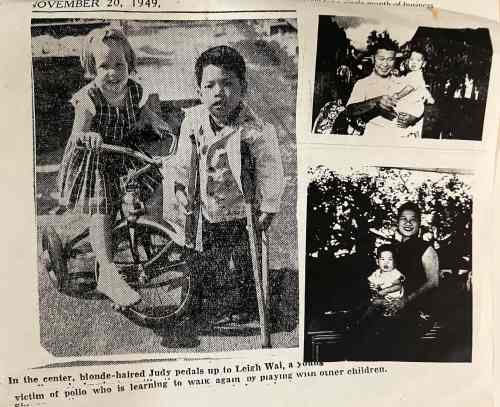 Photo courtesy Leigh-Wai Doo |
Use what gifts God has given to us personally said my classmate, Charley Wedermeyer over 30 years ago , through the twitches of his cheeks and eye, read by his wife Lucy. And they inspire me today.
Surfing from age 12 through 17 was my passion and shaped my entire life, character, attitude, spirit, and health. After surfing, leaving the water over 1000 times, I always left the ocean happy, like the endorphins always kicked in. Surfing created who I am today despite polio weakened legs requiring two long leg braces and crutches and then 50 years later requiring total reliance on wheelchairs due to post Poliomyelitis. And I am very grateful for the blessings of life however I have it and expect to have it for the next quarter century beyond my present age of 77 years old. Surfing reinforced my beliefs to be optimistic, take risks, do things -even if it requires doing it differently. Have no fear- Just awareness and preparedness if possible. Knowing I never drowned nor yet died , embrace the goodness of nature. Love Living Life with Aloha, Bo Ai Universal Love, and Brotherhood to all others and things of nature.
 With grandson Felix 2022. |
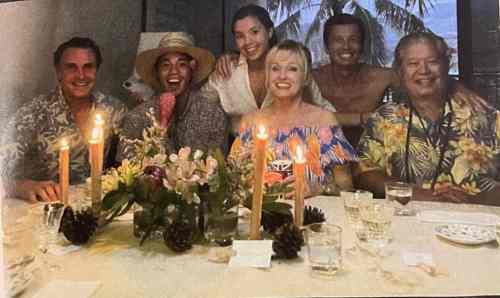 With family for Thanksgiving 2022. |
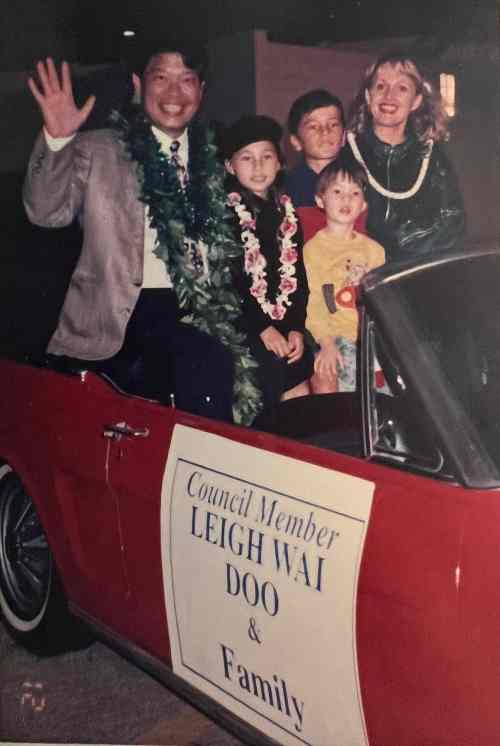 Photo courtesy Leigh-Wai Doo |
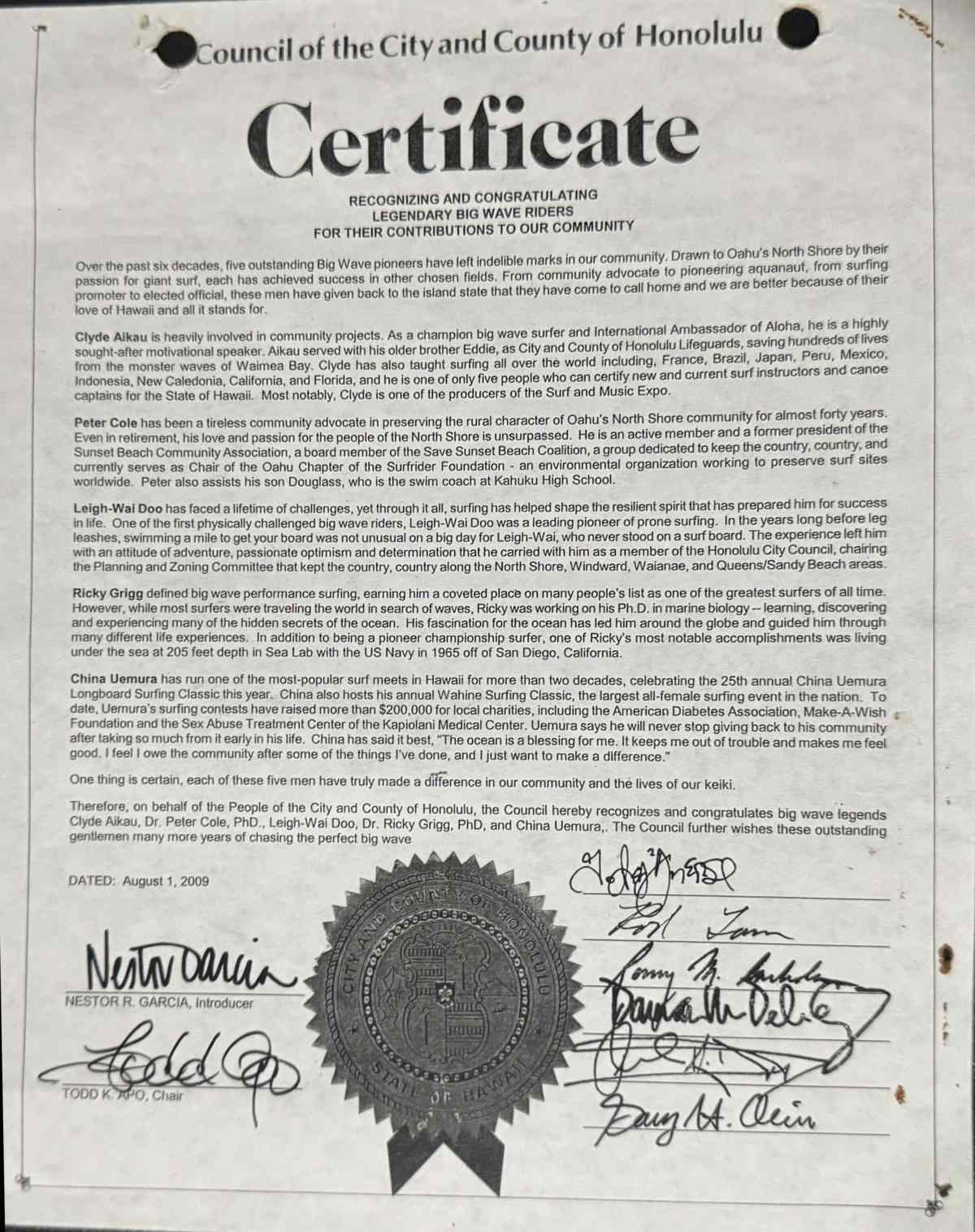 Photo courtesy Leigh-Wai Doo |
To listen to another interview, see Hawaii Public Radio interview by Catherine Cruz, published August 29, 2022 Former Honolulu council member Leigh Wai Doo reflects on life with polio